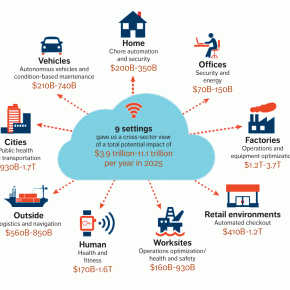The IoT Pie – How to Grab Your Slice

The Internet of Things, or IoT, has been a popular phrase in business over the last few years, with the number of IoT solution providers growing faster than ever. In his article, Peter Smith, UK Technical Sales Manager at EnOcean, discusses the best way for them to establish in this cross-industry market.
First of all: what is the Internet of Things?
The Internet of Things (IoT) is the concept of connecting any number of devices to the Internet. The IoT is a vast network of connected things, everyday objects such as white goods, lighting, smart devices and even people!
What do all of these things have in common? They all have the potential to collect and share data including how and when they are used and create benefits in a number of areas of everyday life. Connected devices can range from anything such as smart lighting to smart phones, connected footballs to fitness devices or building system automation to autonomous vehicles.

Is it possible for one provider to claim a large slice of the IoT pie?
There is a simple answer here: No. Why is this?
The only way one provider could dominate the market is to build a strong ecosystem to offer a full solution. To do this, there are a number of factors which must be considered before tackling the IoT market. First of all, it should be noted that building automation companies, software providers, hardware manufacturers and many more want a slice of the IoT pie.
In a world where large corporates used to throw money at new technologies and solutions to increase market share or move into new markets, they could be forgiven for thinking the same approach would work for IoT. We are now almost five years into the IoT hype, yet no big corporate is an outright market leader for IoT.
IoT is cross-industry and cannot be contained in a single market. To gain market share for any IoT related industry, you need to understand that one company is unlikely to have a large scalable solution without partnering up with other solution providers, and therefore building an ecosystem.
How do you create an IoT ecosystem?
To create an ecosystem of partners for IoT, you should first decide upon which industries you want to target (more about these industries below, and in future blog posts). An ecosystem of ecosystems will be necessary if you target cross-industry solutions.
There are five main types of partner you will need in your ecosystem:
- Cloud solution provider:
Big players in the cloud market are IBM, Microsoft, Google and AWS, but there are many more to choose from and different offerings to meet different solution needs. A cloud solution is needed to host and analyse data, whether that be just storing data points or using the information to determine further actions. - Network type, and therefore, provider:
As IoT is all about connected devices providing data to give insights, some kind of network is needed. There is a huge range of networks, all of which have their place in the IoT space. The networks used could include, but are not restricted to, Wi-Fi, cellular (2G, 3G, 4G etc), radio (Bluetooth (BLE), EnOcean, Zigbee etc), LoRaWAN and other long range networks. - Device manufacturer/supplier:
The number of different devices applicable to IoT is astronomical and there will be billions of connected devices within the next few years. Devices can range from simple magnetic sensors (e.g. to remotely check, whether a door is open or closed) to state of the art healthcare machines which could monitor the vital signs of critically ill patients. Some devices will be cross-industry, whereas others will be industry or niche specific. However, the common factor are self-powered sensor nodes in the IoT as wires and batteries are too costly and maintenance-intensive to power this mass of devices. - Gateway manufacturer/supplier:
To connect all of these devices to a cloud solution, you will need some form of gateway to create that bridge between the raw device data and the cloud platform. Gateways can be simplistic and just transfer the raw data, or they can be much more complex and use edge processing to only send relevant data in a form that the cloud platform understands. Gateways will also differ based in the type of network used. - Installation partner:
Depending on the solution that needs to be installed, it is likely that you choose an installation partner, especially for any industry sized applications. Having an industry expert who understands how the solution needs to be installed, alongside all relevant health and safety aspects, is key to any IoT solution.
Key IoT industries
There is a huge number of IoT applicable industries, and this is growing month by month. For companies to target IoT industries, it would be advisable to pick a small number (1-3) of industries to focus on, at least to start with. During this blog series, I will focus on different industries in each post, starting with Ambient Assisted Living and Healthcare.
Key industries include:
- Ambient Assisted Living
- Healthcare
- Smart Home
- Smart Vehicles
- Asset Management
- Energy Management
- Facilities Management
- Insurance
- Manufacturing
- Agriculture
- Supply Chain
 Peter Smith joined EnOcean as UK Technical Sales Manager in July 2017. Peter has responsibility for IoT Solution Sales and Business Development, with Building Automation, Ambient Assisted Living and Insurance being focus areas. Prior to joining EnOcean, Peter Smith worked for IBM as a Watson IoT Partner Manager and in this role, he was responsible for EnOcean becoming a key IBM Watson IoT Partner.
Peter Smith joined EnOcean as UK Technical Sales Manager in July 2017. Peter has responsibility for IoT Solution Sales and Business Development, with Building Automation, Ambient Assisted Living and Insurance being focus areas. Prior to joining EnOcean, Peter Smith worked for IBM as a Watson IoT Partner Manager and in this role, he was responsible for EnOcean becoming a key IBM Watson IoT Partner.
https://twitter.com/pesmith24 https://www.linkedin.com/in/petersmith24/




